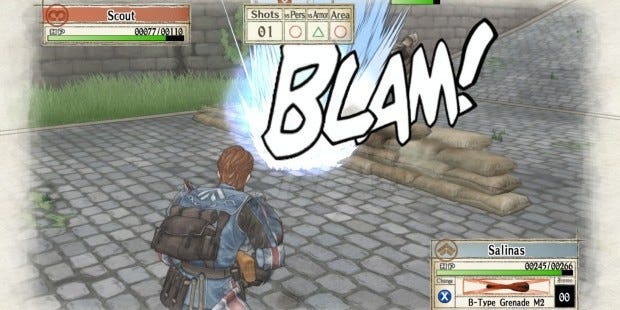Wot I Think: Valkyria Chronicles
Sega puts its 'S' in SRPG
Valkyria Chronicles isn't just a brilliant game, it's a brilliant Sega game. That means something. Contemporary Sega is a multi-headed beast, doomed to forever bear the wound of its exit from the hardware market, capable of both atrocities (the recent Sonic Boom) and beauties like this. But it has until now, with the honorable exception of publishing the Total War and Football Manager series, never really been a PC developer so much as a PC porter of ambiguous distinction. Valkyria Chronicles suggests that Sega, finally, is bringing its 'A' game to the most important platform on the planet.
Valkyria Chronicles was originally released in 2008 as a Playstation 3 exclusive, the terms of which must have recently expired. Lucky for us too, because this is Sega's near-as-dammit perfect attempt to take top-down turn-based strategy and blend it with significant parts realtime control. Hybrids like this can often go wrong, mixing elements and dulling them all, but Valkyria Chronicles intersects systems in a way that they cover each other's weaker points. The cherry on the cake is how everything ties together around a squad system that takes account of interpersonal relationships, a multifaceted R&D arc, levelling up units, learning new battlefield orders, and a thoughtful, sometimes dark narrative reflecting on World War 2.
Especial importance is placed on the narrative, with the main in-game menu a lavish reproduction of a history book about your exploits, which splits up the cutscenes and battles into selectable illustrations. Your nation Gallia is a mix of WW2-era Belgium and Holland – i.e. the neutrals – stuck between the evil eastern Empire of Russia and the sneaky Western Federation. Perhaps the most striking thing about this story, however, is that it's being told by a Japanese developer. Japan's history in WW2 hardly needs a reprise, so perhaps an equivalent is imagining an American developer making a game about the Vietnam war from the Viet Cong perspective.
Anyone who's grown up in the west is familiar with how heroic and unassailable our western forces have always been. But here both sides are humanised, with the necessary cackling villains contrasted with their normal, scared soldiers, and the worst parts of both laid bare. The Empire and Federation are aggregate entities, of course, but their actions have clear reference points – some of which are WW2's worst. Though Gallia's merry band are the heroes of the piece, the things they see are often grim, and the perspective they have on these two warring giants are unsparing. It's not exactly Apocalypse Now, but it's a fresh perspective on a conflict that has a sometimes mythical status for the west.
The beauty of Valkyria Chronicles is that, if you're not a history or a narrative buff, the book format lets you just jump to the missions in each chapter – a 'skirmish' tab in the book offers standalone battles, and at a certain point missions become replayable. The book menu ties many disparate elements of Valkyria Chronicles together, letting you easily flick between headquarters (where all the levelling and research is done), the campaign, and many incidental additions that give the characters and world a little more flavour. This can be checking out war decorations, funding a war journalist's ongoing chronicle of the conflict (parts of which you can read), balancing out personalities in the squad (they have strengths, preferences and petty bugbears), or reading through the tidbits stashed everywhere.
All of this is wonderful, but it's on the battlefield where Valkyria Chronicles really delivers. Each army takes turns, and spends limited action points to move each unit – one for a soldier, two for a tank. Before and after every move you view a top-down 'map' of the environments that shows your units plus visible enemies, and when you've chosen who to control the camera swiftly zooms 'down' to a thirdperson perspective behind them.
The thirdperson view is the realtime part of Valkyria Chronicles, where you run your soldiers around from cover to cover and try to get the jump on enemies – at which point you can snap into aiming mode, where time stops, line up a shot and then the attack is played out. So the shooting mixes thirdperson aiming mechanics with the traditional random number generator of turn-based strategy, but thanks to your precision and target choice having an impact on the latter they don't clash – there's an element of skill, but not to the extent it occludes the importance of approach and positioning.
Movement is what realtime improves on within the turn-based structure. Many turn-based games are also grid-based, and / or depend on hard and fast rules for things like cover. The terrain here is much more varied and important, with elements like sightlines and partial cover having a greater degree of subtlety. Characters move a set distance every turn but are able to perform one action at any point; so can run out of cover to get an angle, take a shot, and then dash to another piece of cover.
The best example of how the battles blend realtime and turn-based actions is the overwatch equivalent – certain classes always fire on enemies who cross their line of sight, while others can't. If you're trying to get past this you can dodge out and trigger the overwatch fire, then when they're reloading dash across the gap. It's hard to see how a tactic like that could be turn-based, but it's key here and feels great to execute – and at the same time doesn't 'nerf' overwatch, because if you run around corners blindly you'll still get shot up.
This is perhaps the defining quality in Valkyria Chronicles' design – it plays like the developers sat down and really thought through how every part of it would work. The classes all complement each other beautifully, with clear roles and utter co-dependence. The scouts see further and run faster for longer than the other classes, for example, and arcing lines shoot out with an audio cue as they flag up multiple enemies – letting the slow-moving snipers set up angles, warn of enemy flanks, and identify key target enemies. But run around carelessly and one enemy on overwatch will take you down in seconds – at which point all the info is hidden again. So controlling a good Scout is about getting into position, but equally as important is being sneaky to keep them alive.
There are smart, balanced touches everywhere: the action points both armies have are spread across their units such that if you prioritise taking out 'commanders' the enemy becomes less mobile, and the same can happen to you. When troops are downed they can be evacuated if a friendly character gets to them within three turns – which in the fraught later battles becomes a huge decision, and forces you to dodge across battlefields in realtime, not least because you care about your squad a great deal by that point. Sometimes the enemy is closer and won't hesitate to finish off your downed troop, meaning that the extraction mechanic is a necessary and needed safety net but also not something you ever want to depend on.
On top of this the missions themselves vary greatly in terrain and the tactics required, with huge switches in pace that mean you never quite know what to expect – a long, gruelling trench battle with limited visibility and mines everywhere, a freewheeling escape mission, a hunt through city streets for saboteurs, or a good old-fashioned head-to-head slugfest. This is one more aspect of turn-based strategy that the realtime parts are able to improve on – in many RTS games (not all) you often learn what to do in a level by playing it once and failing. Here you can respond to changing circumstances with a flexibility of movement that makes even the nastiest of surprises feel surmountable.
Finally the outstanding visual style, which looks like cel-shading overlaid with a paper or parchment effects, together creating the effect of a moving pen-and-ink drawing. This feeds into the overarching book theme, and is a rich contrast to the 'hand-drawn' overhead map of the battlefield. Layered atop this is comic-book onomatopoeia ('Boom!', 'Wham!' etcetera) to accentuate gunfire and explosions, clear visual aids to flag enemy combatants, and plenty of incidental effects like wind and feet kicking up dust. There are countless minor effects, such as how the edges of the screen drain of colour when you're aiming, that give every moment an impeccable stylistic polish.
Such beauty is the main reason why Valkyria Chronicles is a great port, because in-game you can run it at any resolution you want – I was running it at 1920x1080 at 60FPS, but it's possible to go much higher, and the visual style scales amazingly well. The only exception is the cutscenes which retain their PS3 resolution, but it's hard to be too critical of this when the only alternative was re-making them completely. The loading times are extremely fast, and credit also for including the game's DLC expansions as standard and releasing it at a mid-range price.
I said Valkyria Chronicles wasn't just a brilliant game, but a brilliant Sega game. There's an element of wishful thinking to that, but for me Sega has always been one of those developers that occasionally touches perfection – and with unexpected, original games. The mechanics Valkyria Chronicles uses are potentially dissonant, but the game is a unified whole as well as a work of real craftsmanship. It feels like a labour of love. Yes it was on PS3 six years ago. But there's a saying I fondly remember. To be this good takes ages.








